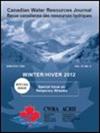阿萨巴斯卡河流域参与式水管理模型
IF 0.9
4区 环境科学与生态学
Q3 WATER RESOURCES
引用次数: 2
摘要
水经常被用于各种相互冲突的目的。此外,由于水是一种动态资源,它的跨界公平分配往往给相关利益相关者带来问题。水资源综合管理(IWRM)旨在促进水资源的跨界协调管理。从理论上讲,综合水资源管理是解决多种相互冲突用途的有效办法,但在实践中难以实施。本文提出了一个综合水资源管理倡议的案例研究,其中参与式建模的关键组成部分发挥了作用。其他重要的过程也被集成,例如问题结构、社会学习和涉众参与。2016-2017年,代表行业、市政当局、环保非政府组织和联邦/省政府的约30个利益相关者合作,探索在加拿大阿尔伯塔省阿萨巴斯卡河流域实现可持续流域管理的机会。开发了压力情景(包括气候、土地利用和水资源利用的潜在变化),并用于测试整个流域的一系列水资源管理策略。这些策略在一个集成的建模工具中进行了模拟。通过这一互动过程,探讨了有希望的可持续水管理战略,并为决策者确定了一系列建议。建议包括,但不限于,确定土地保护和复垦的优先区域,建立流内流量需求目标,减少下游流域的通水限制。通过本文概述,这个案例研究表明,现实世界参与式建模工作的例子实际上是可能的。本文章由计算机程序翻译,如有差异,请以英文原文为准。
Participatory water management modelling in the Athabasca River Basin
Abstract Water is often used for a variety of conflicting purposes. Furthermore, as water is a dynamic resource, its equitable allocation across boundaries often poses problems for involved stakeholders. Integrated water resource management (IWRM) aims to promote the coordinated management of water across all boundaries. In theory IWRM is an effective solution to address multiple conflicting uses: however, in practice it is difficult to implement. This paper presents a case-study of an IWRM initiative in which the key component of participatory modelling is played out. Other important processes are integrated as well, such as problem structuring, social learning, and stakeholder engagement. In 2016-2017, approximately 30 stakeholders representing industry, municipalities, environmental NGOs, and federal/provincial government collaborated in order to explore opportunities to achieve sustainable watershed management in the Athabasca River Basin, Alberta Canada. Stress scenarios (including potential changes in climate, land use, and water use) were developed and used to test a series of water management strategies throughout the basin. These strategies were simulated within an integrated modelling tool in a live setting. Through this interactive process, promising strategies for sustainable water management were explored, and a series of recommendations for policy makers were identified. Recommendations include, but are not limited to, identifying areas for land conservation and reclamation priority, establishing in-stream flow need targets, and reducing water navigation limitations in the lower basin. Outlined through this paper, this case-study shows that examples of real-world participatory modelling efforts are in fact possible.
求助全文
通过发布文献求助,成功后即可免费获取论文全文。
去求助
来源期刊

Canadian Water Resources Journal
WATER RESOURCES-
CiteScore
2.90
自引率
5.90%
发文量
17
审稿时长
>12 weeks
期刊介绍:
The Canadian Water Resources Journal accepts manuscripts in English or French and publishes abstracts in both official languages. Preference is given to manuscripts focusing on science and policy aspects of Canadian water management. Specifically, manuscripts should stimulate public awareness and understanding of Canada''s water resources, encourage recognition of the high priority of water as a resource, and provide new or increased knowledge on some aspect of Canada''s water.
The Canadian Water Resources Journal was first published in the fall of 1976 and it has grown in stature to be recognized as a quality and important publication in the water resources field.
 求助内容:
求助内容: 应助结果提醒方式:
应助结果提醒方式:


